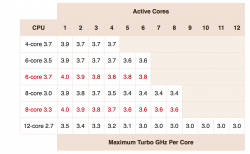Based on what I´ve followed on this forum and other forums, everyone is getting the 6-core, why is that? What´s wrong with the 8-core or 12-core?
Some even say the 6-core is faster than the 12-core. How can this be? 12-core is $3000 more.
Will I waste my money if I get the 12-core?
Some even say the 6-core is faster than the 12-core. How can this be? 12-core is $3000 more.
Will I waste my money if I get the 12-core?


